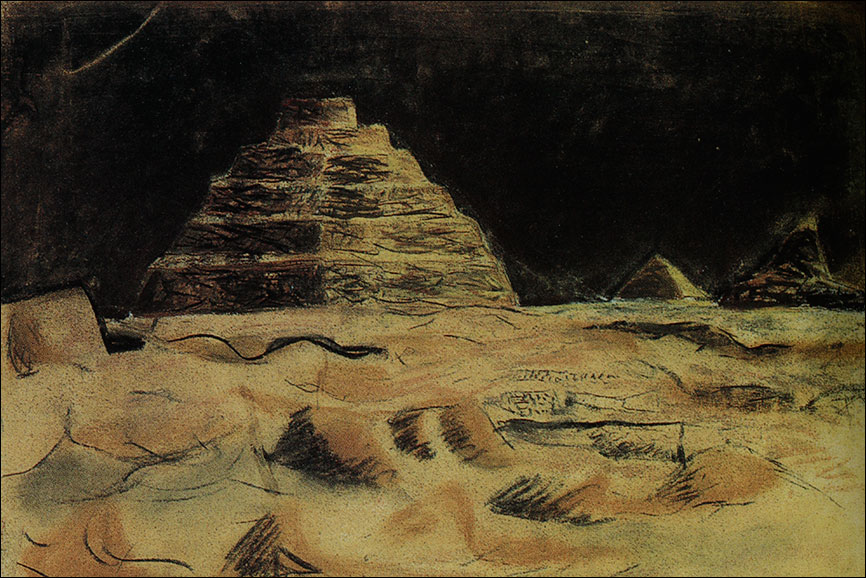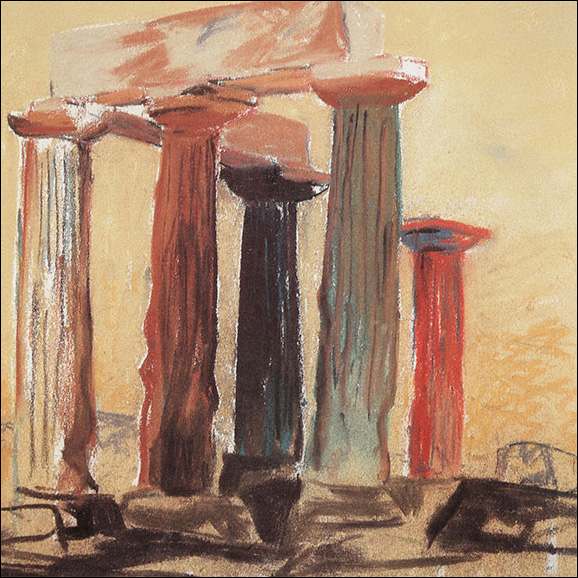
TRAVEL SKETCHES AND ROADMAPS
Peter Lanken architect
Oscar Wilde described the existence of two parallel worlds: one is the world of everyday reality, which everyone experiences, and of which, therefore, we must never speak; the other world is the world of ideas, which exists only if we speak of it, and of which, therefore, we must always speak.
For Louis Kahn, architecture existed in the second world, and he spoke of it lyrically, in allegory and parable. Years ago, this writer heard Kahn speak of the “golden dust of tradition,” and saw the room filled with a metallic mist, floating and glowing.
But now we have only his buildings, and his writings, and his sketches, to tell us what he knew of that world, and, maybe, to show us how to get there. Forty of his travel sketches (out of a recorded total of some 580) are on view at the Canadian Center for Architecture, in an exhibition entitled An Architectural Odyssey: The Travel Sketches of Louis I. Kahn. Most of them are from his first European trip of 1928-1929, from his travels in Québec and Nova Scotia during the 1930’s, and from his second European trip of 1950-1951.
Kahn could always draw, and, after four years at the Beaux-Arts University of Pennsylvania, knew his Orders intimately. He knew what Edwin Lutyens wrote: “You cannot play originality with the Orders. They have been so well digested that there is nothing but essence left. When right they are curiously lovely and unalterable….every line and curve the result of force against impulse through the centuries.” But during the 1920’s, he saw his teacher at Pennsylvania, Paul Philippe Cret, doing just that. Cret, and others, were trying to simplify classical architecture, as we see in his Folger Library at Washington, and in a hundred post offices in Canada. At the same time, the European moderns were trying to eliminate the Orders entirely. Kahn probably suspected, by the time of his first European trip, that once belief in the Orders was shaken, the sources of Architecture must be sought at a deeper level. So even in the early European sketches, we see little architectural detail, only graphic compositions of Italian towns and maritime scenes.
I had the privilege of visiting the exhibition with James Fox, one of Montréal’s best and most knowledgeable architect-draftsmen, and Michael Lewis, architectural historian and curator of the show. They were effusive in their discussions of the early drawings, identifying techniques, tracing conventions and influences from Philadelphia, the American Regionalists, Art Deco, and so on.
But the later drawings were harder to analyse: “more personal,” suggested Fox. But I believe they are less personal, closer to the timeless, elemental Spirit of which Kahn would later speak.
For here is Kahn, returning to Italy after twenty years, and then going back in time to Greece and Egypt. He draws the Acropolis, but shows only the merest hint of the Parthenon. He draws Delphi, where architecture no longer exists, leaving only the land. He draws the temples of Egypt, and shows the archaic stepped pyramid at Saqqara absolute under a blackened sky, then he goes to the quarries where the stone itself was cut. Trying to get back in time, trying to get behind the details of Architecture to find its real elements, as final and indivisible as the Orders.
And drawing, as never before, in pastel, which “could be made to burn with light,” as Vincent Scully says, “to smolder with the heat of the matter it was trying to record under the classical sun….columns of heat, gates of fire.”
The Spirit of Architecture that Louis Kahn discovered won’t be yours. The value of his explorations and of the roadmaps he left us are the same as those left us by Palladio and Hawksmoor and all the others. Each of them showed us that Architecture does exist, up there where the clouds tumble and the thunder is born, and that it can be perceived, if only darkly.
Architectural Odyssey: The Travel Sketches of Louis I. Kahn, an exhibition held at the Canadian Center for Architecture, octagonal gallery, from 19 May to 29 August 1993.
